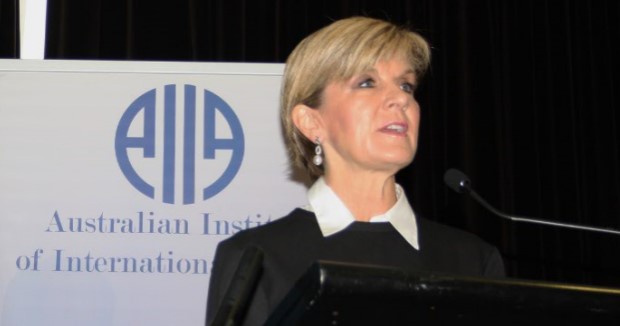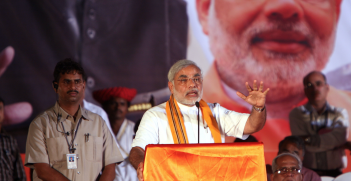Australian Foreign Policy: The Coalition Approach

This paper is part of the Australian Journal of International Affairs’ 2016 Federal Election Special and outlines the Coalition’s approach to international affairs. The full document can also be viewed here.
Supported by one of the most professional and dedicated foreign policy bureaucracies in the world, one can rely on any Australian government that wins office to perform their duty to represent our country in a diligent and tireless manner. The difference lies in whether a government entering, or returning to office is offering a credible vision of what the country’s most important national interests might be, and a sound and practical understanding of how best to advance such interests on behalf of the Australian population. This article looks at the thinking and achievements behind Australian foreign policy under the Coalition government since it came to office in 2013, and the intention of the Malcolm Turnbull government to build on these foundations to further advance the country’s interests in Asia should it win the 2 July election.
Challenges and opportunities in an evolving Asia
Asia has enjoyed a period of relative peace and stability over the seven decades since the end of the Second World War. Rapid economic growth means that more people have been lifted out of poverty over this period than at any other time in human economic history.
These strategic and economic blessings are intimately linked. From the 1950s, Asian successes were made possible by the emergence of an open and liberal order. This order is characterised by open markets and trading regimes, free and open access for all nations to the global commons (especially sea, air and cyber domains), and a rule-of-law system in which governments do not interfere in the legitimate activities of commercial firms and individuals and where disputes are resolved through negotiation and other dispute resolution processes, rather than through intimidation or force.
This liberal order was underwritten by the uncontested maritime power and reach of the United States. The regional security architecture was built on the back of bilateral alliance relations between the US and countries such as Japan, South Korea, the Philippines, Thailand and Australia. Importantly, although the US only has formal treaty alliance agreements with five countries in the region, the liberal order was open to all countries to participate in and benefit from. As the 2016 Defence White Paper summarises:
“The growing prosperity of the Indo-Pacific and the rules-based global order on which Australia relies for open access to our trading partners are based on the maintenance of peace and stability. Over the last 70 years that peace and stability has been underpinned by a strong United States presence in our region and globally as well as active engagement by regional states in building a rules-based order.”
In short, the order was not aimed at permanently containing or suppressing the rise of any one country. Countries large and small have and will continue to benefit from this liberal order: from fully industrialised countries such as Japan, South Korea, Singapore, Taiwan, New Zealand and Australia to low- and middle-income countries such as Malaysia, Thailand, Indonesia, China and, more recently, Myanmar. However, there are a number of challenges and disruptions faced by the region from which we cannot escape or ignore. There are also immense strategic and economic opportunities for an advanced and innovative country like Australia if we can adopt wise policies and continue to position ourselves astutely in Asia.
Preserving and strengthening the existing strategic order
The resilience and success of the post-World War Two strategic order is dependent on the continuation of two propositions: 1) it would be an immensely costly, if not futile, endeavour for any country to seek to challenge and overturn that order; and 2) the benefits to one’s national interests of preserving the existing order far exceed the purported benefits of undermining it.
To be sure, the challenges in the region remain considerable. One enormously important issue is the Australian role in supporting the peaceful re-emergence of China as a regional and global power. This must be performed in a way to ensure that an increasingly powerful China emerges as a responsible and constructive contributor to regional affairs, and eventually assume its rightful place as a regional leader within that order. To that end, it is essential that Australia join collective efforts with regional allies and partners in convincing China that the benefits of integrating into the existing strategic order and eventually assuming a leadership role in that architecture is overwhelmingly in Beijing’s interest. This will require a number of complementary approaches.
One is the strengthening of bilateral relationships between like-minded countries to reinforce the existing security order. There is unanimous agreement within the Coalition with respect to the importance of deepening security cooperation and preserving the ANZUS alliance agreement as the bedrock of Australian security policy well into the future. Additionally, the Coalition has strongly supported Prime Minister Shinzo Abe’s national security reforms and his government’s desire to play a more proactive role in the region’s strategic affairs. At the same time, the Coalition has significantly increased Australia’s military and intelligence sharing cooperation with Japan. This has paved the way for future bilateral and trilateral military cooperation in areas such as the Joint Strike Fighter, air and missile defence, and maritime warfare activities with Japan and the US.
Just as trilateral cooperation with the US and Japan reinforces the existing US-led security architecture well into the future, the Coalition’s military diplomacy in Southeast Asia is rapidly advancing. For example, in April 2016, the government concluded a Comprehensive Strategic Partnership with Singapore. The agreement included providing training facilities for Singaporean forces. Other initiatives include a Joint-Declaration of Strategic Partnership in November 2015, and a Declaration on Enhancing the Australian-Vietnam Comprehensive Partnership in March 2015.
These and other similar initiatives with countries such as India, Indonesia and the Philippines are not being pursued for activity’s sake. The unifying principle driving strategic and military interaction is to enhance the existing liberal order that has served Australia and the region so well. These priorities define the strategic objective behind more intimate military cooperation with various countries. A consistent message emphasising a rules-based order is reflected in all conversations and subsequent communiqués with other capitals when referring to common interests. Likewise, the logic of multilateral engagement share similar purposes to bilateral ones. The Coalition’s participation in forums such as the East Asia Summit and Shangri La Dialogue will continue to be used as opportunities to reaffirm the overwhelming preference of almost all regional countries for the preservation of the existing liberal order—including the stipulation that all territorial and maritime disputes be resolved through negotiation and according to principles consistent with international law.
Australian strategic policy in general, and the 2016 Defence White Paper in particular, should be understood in this context. In the latter document, regional maritime issues are identified as the primary determinant of Australian force posture over the next few decades. Excluding the US and Northeast Asian great powers, the Coalition is committed to ensuring that Australia possesses the most formidable maritime capability of any resident nation in Southeast Asia.
The ambitious upgrading of defence capability and robust posture is not driven by imprudent national pride. It signals the Coalition’s desire that Australia accept a greater burden in joining with allies and partners in reinforcing the existing strategic and liberal order—and join with the same allies and partners in persuading other nations that the use of force or coercion to challenge that order will be costly and ultimately futile. This acceptance of responsibility is recognition that future Australian prosperity is dependent on a stable and liberal order, and that Australia cannot isolate itself from developments in Asia. We must play a larger part in shaping a future order that serves our interests. In other words, a larger Australian strategic role will enhance the prospect of peace and future stability in Asia.
It is worth noting that the consistency and clarity offered by the Coalition with respect to Australia’s strategic policies and interests will improve our relationships with allies. Such consistency and clarity will also reassure and improve relationships with countries with whom we have differences or disagreements. For example, the Coalition has joined with other countries such as the US, Japan, India, Vietnam and the Philippines to criticise Chinese actions in the East and South China Seas. At the same time, we have explained to China and other countries that Australian strategic policy is designed to counter policies and behaviour by countries and other entities that threaten order and stability in the region; Australian policy is not permanently directed against any country.
This explains why the Coalition upgraded relations with China in forging a Sino-Australian Comprehensive Strategic Partnership in 2014. We have been deepening military engagement with China, as occurred during the 18th Strategic Defence Dialogue with Beijing in December 2015. The objective is to join with security allies and partners to persuade China that it will continue to benefit from rising within the existing strategic order, and that Australia will welcome China as a strategic leader in the region if Beijing continues to do so. That it is in China’s own interest to abide by existing rules and norms was the firm message delivered by Prime Minister Turnbull during his visit to Beijing in April. It will continue to remain so.
Finally, there are many other regional challenges, even if managing strategic relations with the great powers of Asia will continue to absorb the time and attention of any future Australian government. Provocations by a nuclear armed North Korea against South Korea and Japan will have wider ramifications—reinforcing the importance of deterrence founded on American nuclear and military power in Asia. It is for this reason that we continue to reject emotionally seductive but impractical policies such as advocating for nuclear-free zones in East Asia. Doing so would lead to unintended consequences of possibly catastrophic proportion.
In Southeast Asia, terrorism, people smuggling and other trans-national crimes and injustices will need Australian attention. All of these problems require close cooperation with regional partners. In the world of diplomacy, unnecessary surprises and impulsive changes in policy will almost always lead to poorer outcomes for Australia—such as the sudden ban imposed on live cattle exports to Indonesia by the Labor government in 2011. On this measure, the Coalition will continue to demonstrate the benefits of possessing a steady diplomatic hand in the region.
Economic diplomacy and opportunity in Asia
The previous section focused on the traditional subject matter of foreign policy, which is strategic and security affairs. More neglected but as important is economic diplomacy. Just as the traditional objective of foreign affairs is peace and security, the goal of economic diplomacy is to examine the drivers of growth and prosperity and determine how better to position one’s country to take advantage of existing and emerging opportunities.
While preserving stability and protecting the pillars of the regional liberal and strategic order offer the prerequisite conditions for Australian prosperity and regional economic development, national capacity to realise opportunities in Asia will continue to be shaped by Australian government policy settings and priorities. As Australia transitions away from a commodities boom, our future prosperity will depend on understanding the ways in which the economies and societies in Asia are evolving, and subsequently shifting the nature of our own economic interactions with the region.
There is much excitement with respect to Asia’s future. While different countries in the region have enjoyed rapid economic growth since the 1950s, there are still only a handful of fully industrialised countries: Japan, South Korea, Singapore, Taiwan, Australia and New Zealand. Even after decades of rapid growth, China’s GDP per capita is around one-fifth that of Australia’s. This means that of the more than four billion people throughout the Indo-Pacific, fewer than 250 million live in fully industrialised economies. That speaks to the enormous potential for continued growth in our region.
Even so, growth in any region is never uniform nor guaranteed. There is much speculation with respect to Asia’s economic future. When it comes to economic diplomacy and planning, one can nevertheless focus on trends that are almost certain to occur; on this score, we can point to two. The first concerns demographic trends. It is well known that all of Asia’s advanced economies, especially Japan, faces an ageing demographic which will resemble the situation confronting many countries in Western Europe. Less well known is the fact that every country in Southeast Asia—with the exceptions of the Philippines, Indonesia and Malaysia—will face the challenge of a rapidly ageing society from the next decade onward.
Undoubtedly, China confronts the most dramatic challenge in this regard, largely because of its ‘one child policy’ first introduced in 1978. When the country was still in the middle of its rapid growth path two decades ago, there were approximately six working persons to every person of retirement age. In fifteen years, there could be as few as 2.5 working persons for every retired person in the country. In 2015, more people left the workforce in China than entered it for the first time in its history. For China, and also for many Asian countries, the so-called demographic dividend—referring to an enormous pool of surplus labour that the economy could cheaply deploy, especially into manufacturing—is rapidly diminishing. There is also little prospect that immigration into ageing Asian societies will be sufficient to change the age demographics.
This leads to a second trend in the region: the benefits of the aptly named East Asian export-orientated model of rapid development will gradually taper off. In the 1980s, the combined population of exporting powerhouses Japan, South Korea, Taiwan, Singapore and Malaysia exceeded 150 million. In turn, the population of advanced consumer markets in North America and Europe numbered around 400 million. That equation is now reversed. There are some one billion consumers in advanced countries around the world compared to two billion people living in the developing countries throughout East Asia.
Even now, too many goods are being produced for export with too few consumers to buy them, even as the era of cheap, young surplus labour in many parts of Asia is steadily diminishing. When one takes into account the disruptive effects of advanced manufacturing technologies (such as robotics, automation and 3D printing, which will make many traditional manufacturing jobs obsolete), it becomes clear that the export-orientated model of growth will play a relatively smaller role in the decades ahead in driving regional prosperity than it did just a decade ago. Knowing that what worked well in the past may not work so well into the future, these and other trends are forcing our Asian neighbours to conceive of other ways to achieve rapid growth. Fortunately, there are vast opportunities in the region that will be of high relevance to Australia’s future economic role.
According to OECD figures, less than one fifth of the world’s middle class was from Asia at the beginning of this century. In just over a decade’s time, up to two-thirds of the world’s middle-class may well be living in our region. This means that rather than Asia making merchandise goods for consumers in other regions, Asians will become major global consumers. Moreover, as the regional middle classes grow in size and wealth, their consumption preferences will invariably change. Regional consumption will no longer be about basic needs and wants such as food, clothing, mobile phones and cars. There will be rapid demand for better quality food and clothing and more expensive or sophisticated products. Regional consumption will be increasingly based on services, especially as populations acquire wealth and grow older. This will include financial, superannuation and tax advice from accountants, financial planners and lawyers. World-class architects throughout the region will be in greater demand. Those ageing will want world-class health and aged care. Those ageing but still in the workforce will need new qualifications from globally recognised institutions as they transition into a changed workplace. In short, more and more regional households will consume similar goods and services available to Australians.
Tapping into these trends will help drive the next few decades of prosperous interaction with our region. Australia will remain a great commodity exporter, while we are already an energy superpower in the global economy. We are the largest beef exporter and major exporter of grains, horticulture, dairy, wine and seafood into Asia. We have a key advantage in producing food products that are safe and reliable. There is even greater opportunity ahead. The trends outlined above will allow Australia to reverse an imbalance at a time when commodity prices are falling. For the moment, more than two-thirds of our domestic economy consists of services, yet less than one-fifth of our exports is in services. As regional demand for world class services increase, Australia is well positioned to meet some of that demand.
This brings us back to the economic diplomacy of the Coalition government. As Prime Minister Turnbull reminds us, there is immense opportunity during moments of disruption and change such as that now taking place throughout the region. It is with these changes in mind that the government prioritised the conclusion of trade agreements with our largest and most important Asian trading partners in China, Japan and South Korea. These free trade agreements (or FTAs) are designed to ensure that innovative and advanced economies such as ours are better placed to take advantage of opportunities arising out of the trends mentioned.
Indeed, independent modelling has found that these FTAs will boost our GDP by $25 billion over the next two decades, which equates to each Australian household being $4,000 better off. Some of the highlights that make our exports more competitive include the elimination of tariffs for our dairy, beef, lamb, wine, horticulture and seafood exports into China. The China-Australia FTA opens up opportunities for Australian private hospital providers and our aged care sectors to target what will be the largest ageing population in the world.
Our FTA with Japan is the most ambitious trade deal Japan has ever concluded with another country. When fully implemented, more than 97 per cent of Australian exports will enter Japan duty free or with preferential access. Tariffs on many agricultural exports will be eliminated including on wine, seafood, processed food, fruit, vegetables and nuts. Tariffs on Australian beef will be halved while our services sectors will gain unprecedented access to the lucrative Japanese domestic economy. Likewise, almost all our export tariffs into South Korea will be eliminated.
Other recent highlights include the conclusion of a comprehensive strategic partnership with Singapore, another advanced and innovative regional economy with whom we share much in common. This package will enable Australians to work even closer on the commercialisation of research between our agencies, universities and private firms. We will be exploring joint opportunities in sectors such as food and agriculture in Northern Australia. The partnership also promotes mutual recognition of standards and qualifications for our professional and other service firms to allow them to operate in the Singaporean economy.
As we look ahead, the Coalition government intends to negotiate further export agreements with India, Indonesia and a number of Pacific nations. The Australian economy has much to offer an evolving Asia beyond a commodities boom, and the Coalition government will continue to do its part in helping Australians to realise these opportunities.
Conclusion
Although we are in a region of giants, an advanced and innovative country like Australia needs to play a significant strategic and economic role in Asia in a way that will increase the prospects that Asia will continue its path toward becoming an even more peaceful, stable and prosperous region.
In our immediate region, the Coalition has made significant advances when it comes to Indonesia, the world’s third largest democracy and the most populous Muslim nation in the world. This bilateral relationship is underpinned by regular high-level meetings, including the Indonesia-Australia Annual Leaders’ Meeting, the Foreign and Defence Ministers’ 2+2 Dialogue, and the Trade Ministers’ Meeting. Coalition prime ministers have held meetings with Indonesian counterparts four times since 2013, and I have visited Indonesia six times since becoming Minister for Foreign Affairs. These meetings have been productive, with significant advancements in cooperation on counter-terrorism and combating the trade in people smuggling.
Even closer to home, we have prioritised working with Papua New Guinea to build the latter’s national capacity. In 2013, we agreed to establish an annual bilateral leaders meeting between the two countries. We have helped PNG’s Defence Force to strengthen their ability to contribute to domestic security and stability in that country’s immediate region. The bilateral defence cooperation program between the two countries is Australia’s largest with any country and involves provision of training and technical advice with our closest neighbour. Of further note is the Coalition’s support for PNG in implementing its 2013 Defence White Paper in modernising its defence forces. And in November 2015, our two governments launched the Pacific Leadership and Governance Precinct to support and strengthen PNG’s vision to build a more professional and skilled public service to help it continue its rapid development.
Under the Coalition, Australian aid continues to make up a considerable proportion of the GDP of small island states throughout the Pacific—notable examples of which are Tuvalu (25 per cent) and the Solomon Islands (18 per cent). In 2016-17, the Coalition government will deliver around $3.8 billion in development assistance, making us the 12th largest donor in the OECD. We will continue to provide a sustainable aid program that is fiscally responsible. Our lead role in the international response to the downing of Malaysian Airlines MH17 over Ukraine through carriage of United Nations Security Council Resolution 2166 won us new supporters throughout the region following that tragedy. Other initiatives, such as the Coalition’s New Colombo Plan, which provides opportunities for young Australians to spend time in the region, is a critical component of the often underestimated virtue of people-to-people diplomacy with our neighbours.
The Coalition will not rest on its laurels. The government has not fallen into the trap of equating mere activity with achievement. Current and future policies will continue to exhibit clear-sightedness with respect to advancing our national interest. We are proud of our recent foreign policy record in the region, but are nevertheless looking ahead. In embracing the reality of change, disruption and unpredictability, the Coalition’s current and future policies toward an evolving Asia will help ensure the best days are ahead of us.
The Hon Julie Bishop MP is the Minister for Foreign Affairs. She is also the Deputy Leader of the Liberal Party and has served as the Member for Curtin in the House of Representatives since 1998.
This paper is part of the Australian Journal of International Affairs’ 2016 Federal Election Special Section and is published here by permission of the journal. All rights reserved.





